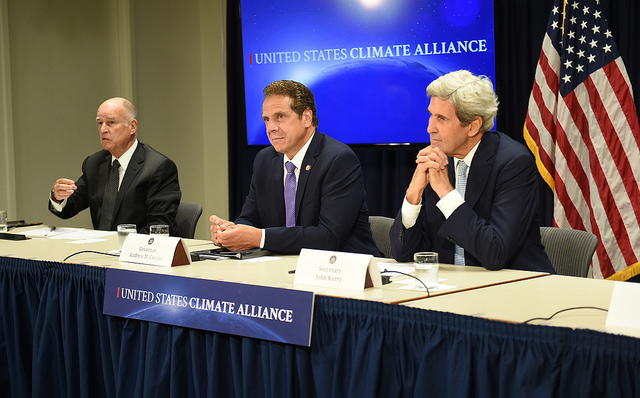 U.S Climate Alliance Press Conference, September 20, 2017
U.S Climate Alliance Press Conference, September 20, 2017
Regional Initiatives: How America Can Still Honor the Paris Agreement
The Trump Administration announced early this summer that it would move to withdraw from the Paris Climate Agreement. Although the United States cannot officially withdraw until November 2020, the intent to withdraw has had a deep impact. As ASP has previously stated, leaving the Paris Agreement signals to the rest of the world that the United States is turning away from its global responsibilities. The announcement impedes efforts to combat climate change, endangers the energy security of the country, calls the country’s credibility into question, and threatens the national security of the United States.
However, groups within the United States have stepped in and pledged to uphold the Paris Agreement’s framework. The U.S. Climate Alliance, formed by New York Governor Andrew Cuomo, California Governor Edmund Brown Jr., and Washington State Governor Jay Inslee, has grown from the original three to twelve states since June. The members of the alliance represent more than 36% of the population of the United States and $7.16 trillion dollars, or over one-third, of the country’s GDP. This economic advantage gives the alliance a considerable amount of economic and political leverage. Officials in 10 more than states, plus the District of Columbia, have also pledged to follow the Paris Agreement, but they have not formally joined the alliance. In addition, 377 mayors across the country have committed to uphold the goals of the Paris Agreement.
Though the pledges are not binding, one analysis found that the United States could meet 60 percent of its Paris commitment through the initiatives of cities, states, and businesses. The Regional Greenhouse Gas Initiative (RGGI), which started in 2009, could serve as an example for regional and local efforts to meet Paris Agreement commitments. The initiative is the first mandatory market-based program in the United States that seeks to reduce greenhouse gas emissions. The RGGI is made up of Connecticut, Delaware, Maine, Maryland, Massachusetts, New Hampshire, New York, Rhode Island, and Vermont and uses a cap-and-trade system to target electric power plant emissions.
Each state has a CO2 Budget Trading Program, which limits emissions through auctions of carbon allowances. Every year, the amount of allowances is set to decrease 2.5%. However, the initiative is considering a pledge to reduce emissions from power plants by 30% between 2020 and 2030, which requires a slightly higher annual decrease. Power plants can either choose to bid on the increasingly smaller number of carbon allowances or they can choose to invest in energy efficiency programs and renewable energy, a choice that provides greater returns in the long-run. Through the auctions, the initiative has raised $2.7 billion, with half of that money being reinvested in programs in energy efficiency and clean and renewable energy. The economies of the RGGI states are growing at a faster rate than the rest of the country, and electricity prices have fallen, even though prices in other states have increased.
Regional initiatives like the RGGI bring more than just economic benefits. The decrease in emissions cuts down on pollution, which has health benefits. The RGGI states estimate that they have avoided 16,000 respiratory illnesses and between 300 and 830 deaths. For New York alone, the program has saved the state $1.7 billion in healthcare costs. Regional initiatives of this kind also contribute to growth through renewable energy development, which adds jobs and new forms of technology to the economy.
Programs like the RGGI have broader benefits as well. By encouraging emission reductions and clean energy, RGGI increases renewable energy technology development and strengthens the energy security of the United States. Moving away from traditional sources of energy and toward cleaner energy ensures that the economic health of the United States will not be dependent on volatile fuel prices and its foreign policy will not be as seriously impacted by the geopolitics of oil. Businesses are also given the space to invest in creating a low carbon economy, which allows them to grow with and operate in a more stable economy that will generate returns in the long-term.
Finally, regional action demonstrates that Americans are still interested in climate issues, even if the federal government has signaled that is not. Over 2,400 subnational groups have said that they will stand by the Paris Agreement, including cities, states, tribes, businesses, counties, and colleges. Though the United States may not serve as an example for other countries to act on climate on a national scale, these regional and local groups can fill the gap and encourage others around the world to follow the Paris Agreement.





